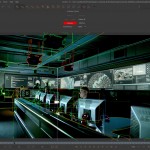
Avatar was filmed with state-of-the-art 3-D cameras, and Alice in Wonderland and G-Force were both converted successfully. The big reason is that both were worked on for months, while Clash of the Titans was converted in about six-to-eight weeks. That’s not near long enough to do a proper conversion.
Here’s a few selections from an interview with In-Three about the 3-D Conversion Process:
Tell me how this process works. Is there a little black box with inputs and outputs and a red button that says “Dimensionalize!”?
Damian Wader: We wish it worked like that!
Matthew DeJohn: It breaks down into three broad artistic phases. One is segmenting the image. You break it up in terms of major layers of depth. You cut out a person [in the scene], maybe somebody else behind him, and then you have the background. The next stage is actually generating the depth for that scene. You model the scene, and our system allows you to create a new perspective, or see the scene from a new perspective once you’ve modeled it out in 3D. And once you are finished with that phase, you’ve revealed parts of the background that weren’t visible in the original perspective, so you have to paint those surfaces, inserting image information where there was none.
[…]
How big is the team for the 2D-to-3D conversion?
MDJ: Generally, for a 100-minute or 120-minute 2D-to-3D conversion, you would need about 300 to 400 artists phasing and out of production over about four to six months.
Are those 400 artists all working on dimensionalization? That’s not at all a trivial process.
MDJ: It’s very serious visual effects work. We have a lot of ways to attack the process that make it easier for us to get people up to speed and control the quality, but it takes a lot of effort to get a very high quality product.
How often do those people have to look at shots in 3D, and how do they do that?
MDJ: Internally, we’re working in 3D the entire time, save creating roto splines and stuff like that. For our depth artists, 50 or 75 percent of the day is spent looking through 3D glasses. We’re submitting stuff for review in 3D internally, because we’ll go through three or four internal reviews before we send to the client.
[…]
And the big question: how much does this cost?
DW: Typically, it’s about $80,000 to $100,000 a minute. That’s generally speaking. As we move forward through development, we can define things that make it more efficient for us and more cost-effective for the production. A lot of animation houses are coming to us. They want to deal with their 2D story, not stereo or CG. Some projects do come to us as legacy pictures, but when we’re involved in the beginning, it’s the best way to take advantage of the process. It will not affect principal photography as a whole, but it will help our efficiency.
MDJ: Because dimensionalization is a post process, you get more artistic control compared to shooting in stereo. We can tailor the depth to match perfectly with the edit. No shots are ever lost if the camera fails. We can go into a stereo show and dimensionalize a flat shot to match the rest of a scene. It provides more flexibility in your depth choices. But you are limited by the realities of the world. If you shot with a long lens, you can only get so much shape out of the character’s face without having the scene way too deep. We can go in and make specific choices and use the available depth budget to its best advantage.
DW: Everything we do is to help the creative get his vision out there. It’s not to take away at all. We want to work with creatives who want to use 3D as a storytelling tool.
[…]
One last question about dimensionalization. Alice in Wonderland got mainly good reviews for its 3D visuals. But as soon as Clash of the Titans started screening for fans, there was a backlash. On the Internet and in some print reviews, a buzz started building that 2D to 3D conversions are no good. [Writing in the Los Angeles Times, Kenneth Turan said, “Consider the possibility that Clash of the Titans is the first film to actually be made worse by being in 3-D.”] How do you feel about that?
MDJ:You bring up Alice as a contrast to that, which is good. I would go back even farther, to G-Force. I don’t think anybody knew that was converted. They all assumed it originated in 3D, because it was really clean. In terms of Clash of the Titans and all of the negative press, we look at that situation and see an eight-to-10-week schedule to do an entire movie, and it sounds completely unrealistic to get a high-quality product in that timeframe. If that’s how it turns out [and 3D conversions get a bad reputation], it will be disappointing for us. We’ve been there at the forefront, talking about our dimensionalization process specifically as an extremely viable and artistically competitive approach to generating 3D. If it doesn’t get there, hopefully that doesn’t paint all conversion houses with the same brush. That’s what we’re afraid of. The audience should be able to trust they’ll get a high-quality product, especially on a huge movie.
If you’d like to read the full interview, click here: In-Three on the Workflow Behind 3D Conversions. I hope that this helps you all to feel more comfortable with the 3-D process, as they have plenty of time to make it look really good. I saw G-Force in 3-D, twice, and it looked good. It’s really fascinating to know exactly how the 3-D conversion process works, and why it didn’t work on Clash of the Titans. On that film, they should have either waited to release it after a proper complete conversion, or they should have merely given it a 2-D release.
